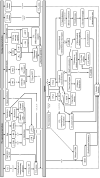Physiology, pathophysiology and (mal)adaptations to chronic apnoeic training: a state-of-the-art review
- PMID: 33791844
- PMCID: PMC8144079
- DOI: 10.1007/s00421-021-04664-x
Physiology, pathophysiology and (mal)adaptations to chronic apnoeic training: a state-of-the-art review
Abstract
Breath-hold diving is an activity that humans have engaged in since antiquity to forage for resources, provide sustenance and to support military campaigns. In modern times, breath-hold diving continues to gain popularity and recognition as both a competitive and recreational sport. The continued progression of world records is somewhat remarkable, particularly given the extreme hypoxaemic and hypercapnic conditions, and hydrostatic pressures these athletes endure. However, there is abundant literature to suggest a large inter-individual variation in the apnoeic capabilities that is thus far not fully understood. In this review, we explore developments in apnoea physiology and delineate the traits and mechanisms that potentially underpin this variation. In addition, we sought to highlight the physiological (mal)adaptations associated with consistent breath-hold training. Breath-hold divers (BHDs) are evidenced to exhibit a more pronounced diving-response than non-divers, while elite BHDs (EBHDs) also display beneficial adaptations in both blood and skeletal muscle. Importantly, these physiological characteristics are documented to be primarily influenced by training-induced stimuli. BHDs are exposed to unique physiological and environmental stressors, and as such possess an ability to withstand acute cerebrovascular and neuronal strains. Whether these characteristics are also a result of training-induced adaptations or genetic predisposition is less certain. Although the long-term effects of regular breath-hold diving activity are yet to be holistically established, preliminary evidence has posed considerations for cognitive, neurological, renal and bone health in BHDs. These areas should be explored further in longitudinal studies to more confidently ascertain the long-term health implications of extreme breath-holding activity.
Keywords: Apnoea; Bone health; Breath-hold diving; Haematology; Skeletal muscle; Spleen.
Conflict of interest statement
The authors have no conflict of interest to declare.
Figures


Similar articles
-
The interaction of breath holding and muscle mechanoreflex on cardiovascular responses in breath-hold divers and non-breath-hold divers.Eur J Appl Physiol. 2024 Jul;124(7):2183-2192. doi: 10.1007/s00421-024-05431-4. Epub 2024 Mar 5. Eur J Appl Physiol. 2024. PMID: 38441687 Free PMC article.
-
Impact of breath holding on cardiovascular respiratory and cerebrovascular health.Sports Med. 2012 Jun 1;42(6):459-72. doi: 10.2165/11599260-000000000-00000. Sports Med. 2012. PMID: 22574634 Review.
-
Splenic responses to a series of repeated maximal static and dynamic apnoeas with whole-body immersion in water.Exp Physiol. 2021 Jan;106(1):338-349. doi: 10.1113/EP088404. Epub 2020 Jun 10. Exp Physiol. 2021. PMID: 32421235
-
The physiology and pathophysiology of human breath-hold diving.J Appl Physiol (1985). 2009 Jan;106(1):284-92. doi: 10.1152/japplphysiol.90991.2008. Epub 2008 Oct 30. J Appl Physiol (1985). 2009. PMID: 18974367 Review.
-
Physiology of static breath holding in elite apneists.Exp Physiol. 2018 May 1;103(5):635-651. doi: 10.1113/EP086269. Exp Physiol. 2018. PMID: 29512224 Review.
Cited by
-
Effects of apnoea training on aerobic and anaerobic performance: A systematic review and meta-analysis.Front Physiol. 2022 Sep 27;13:964144. doi: 10.3389/fphys.2022.964144. eCollection 2022. Front Physiol. 2022. PMID: 36237527 Free PMC article.
-
Going to Extremes of Lung Physiology-Deep Breath-Hold Diving.Front Physiol. 2021 Jul 9;12:710429. doi: 10.3389/fphys.2021.710429. eCollection 2021. Front Physiol. 2021. PMID: 34305657 Free PMC article. Review.
-
On the mechanisms of stress-induced human spleen contraction: training for a higher blood oxygen-carrying capacity.Eur J Appl Physiol. 2024 Dec;124(12):3477-3493. doi: 10.1007/s00421-024-05589-x. Epub 2024 Aug 29. Eur J Appl Physiol. 2024. PMID: 39207549 Review.
-
Effect of dry dynamic apnea on aerobic power in elite rugby athletes: a warm-up method.Front Physiol. 2024 Jan 16;14:1269656. doi: 10.3389/fphys.2023.1269656. eCollection 2023. Front Physiol. 2024. PMID: 38292448 Free PMC article.
-
Multi-Mechanistic Approaches to the Treatment of Traumatic Brain Injury: A Review.J Clin Med. 2023 Mar 11;12(6):2179. doi: 10.3390/jcm12062179. J Clin Med. 2023. PMID: 36983181 Free PMC article. Review.
References
-
- AIDA (2021) World Records. https://www.aidainternational.org. Accessed 12 Jan 2021
Publication types
MeSH terms
LinkOut - more resources
Full Text Sources
Other Literature Sources
Research Materials

